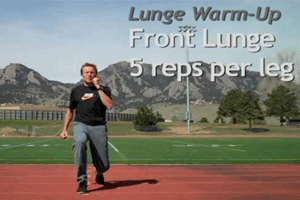The Romans had a neat trick for knowing how far their troops had traveled. They would have a soldier count each time his left foot hit the ground. When he’d reached 1000, they knew they had traveled a mile. Some 2000 years later, researchers at Boise State University confirmed this with data determining the total number of steps to run a 12-minute-mile as 1,951 (compared to 1,064 steps for a 6-minute-mile).
So, why the history lesson?
Well, if I asked you to go and hop 1,951 times you would probably show some initial reservations as to whether your legs are up to the task. And yet, running is pretty much that – an extended series of hopping from one leg to the other whilst trying to minimise ground contact time (with some help from gravity, depending on the efficiency of your running form), and dealing with forces of around 2.5 times your body weight each time your foot hits the ground.
Seeing running as a series of hops can be a useful way to open your mind to the fact that in order to run without suffering injury, you ultimately have a decision to make: either reduce how far you run (i.e. say goodbye to races over a certain distance) or prepare your body for longer distances by adding strength & conditioning exercises to your weekly routine.
Through this new series of weekly articles, my aim will be to help you avoid becoming one of the 30- 70% of runners who get injured every year. We will start by looking at one of the most important and yet commonly overlooked ways of preparing for your run: the warm up.
Is stretching before a run bad for you?
Let’s face it, most runners will welcome any excuse to avoid a 5-10 minute warm-up before a run. We just want to run!
So when research from New South Wales, Australia first suggested over 10 years ago that static stretching (long-hold stretching) did not reduce injury, traditional warm up routines before running were soon ditched in favour of just jogging the first five minutes.
The case against static stretching before a run was further weakened by recent research that suggests it reduces the natural leg stiffness that is required for running efficiency. As the foot makes contact with the ground, this stiffness is said to absorb energy and use it to spring forwards.
Researchers at Florida State University in 2010 showed that trained distance runners became about 5% less efficient and covered 3% less distance in a time trial if they did static stretching before the run.
However, and this is the crunch, all of the above concerns static stretching, i.e. long-hold stretching (like touching your toes for 40 seconds). It is important to differentiate this from dynamic stretching, which involves controlled, repetitive sports-specific movements that mimic the way your muscles and connective tissues will need to stretch during your chosen activity, e.g. swinging your leg forwards 15 times.
A follow up study by Florida State University stated that there is no evidence that dynamic stretching before a run inhibits performance.
Dynamic stretching as a warm-up
Let’s look at an example: one of the major components of an efficient running stride is having enough range of movement in the hip flexor to allow your leg to travel back behind you before your toe leaves the ground. A dynamic stretch that mimics this hip extension, e.g. a lunge, will reduce internal resistance whilst running and improve the efficiency of your stride.
Given that many of us have tight hip flexors due to sitting down all day, a controlled dynamic stretch that progressively increases range of movement in the hip before we start running can help us run more efficiently with better form.
Although there is no evidence that one particular “running style” will reduce injury rate (no one-size-fits-all remedy), certain biomechanical inefficiencies associated with poor running form can be linked to reoccurring injury (more on that next week).
Preparation for efficient running form cannot be achieved by simply preceding your run with a five minute jog.
In being active and challenging, dynamic stretching will also promote the other well documented physical and mental benefits associated with a warm up.
What dynamic stretching should I do?
Which and how much dynamic stretching you do in your warm up will depend on your fitness level and the type of running you plan to do.
You will find many examples online but as always we suggest you consult a professional before embarking on a new exercise routine. The main message I want you to get from this article is that you do something!
I personally am a huge fan of progressive lunges before embarking on a run. Elite running coach Jay Johnson demonstrates physical therapist Gary Gray’s “Lunge Matrix” in the link below, describing it as “quintessential, elemental and fundamental to staying healthy as a runner.” He stresses that “you do this the FIRST thing when you get out of the car.”
Here is a summary of the “Lunge Matrix” seen on the video. You can also purchase the Lunge Matrix as part of Jay’s excellent Building a Better Runner DVD series.
For each version, Coach Jay recommends five lunges are performed on each leg (10 in total).
1. Front Lunge

In this lunge, you are preparing for forwards & backwards movement (the sagittal plane). The front knee needs to stay in alignment with the front foot (same goes for back knee & back foot), but there is often debate as to whether the front knee should pass the toes. Personally, I see stopping the front knee from passing the toes as a way of helping quad dominant runners from using the posterior muscles more, discouraging excessive arching of the lower back and getting a better stretch in the all too often tight hip flexors.
2. Front lunge with a twist

The action of twisting over the front leg (moving your body through the transverse plane) increases the stretch in the hip flexor of the back leg. By challenging your balance it engages the core (including the glutes) and increases proprioception (your body’s ability to sense movement within joints and joint position). It will take some practice so break it down into stages.
3. Side lunge

This lunge moves your body through the frontal plane and in doing so targets the abductors and hip-stabilizing muscles. Aim to keep the fixed leg straight. Personally, I recommend rotating the lifted foot out to 45 degrees so that the knee moves in line with the foot.
4. Back and to the side Lunge

With this lunge, the traveling back foot turns 90 degrees to the side, again allowing the knee to move in alignment. By traveling in a combination of the frontal plane and sagittal plane, you are preparing for the often forgotten rotational demands of running.
5. Backward lunge

The backwards lunge is more challenging than the others but in essence involves the same muscle movement sequencing that is needed in running. It demands more core stability, hip extension and glute recruitment than the other lunges, decreasing hip and ankle stiffness. Or as Coach Jay says “…a great way to explain to your butt that you’re about to use it.”
Where do we go from here?
Like I say, there are plenty of sources for dynamic stretching on the internet: ankle rolls, toe pumps, leg swings, single leg deadlifts, etc. Sourcing is not the issue.
The issue is ensuring you avoid the massive temptation to miss it out before you run. You will come up with every excuse under the sun: “It’s too cold,” “I don’t have time,” “I’ll do extra tomorrow to make up for it.” It’s just five minutes people! Believe me, it will create focus, readiness, and mark the beginning of fewer injuries & improved running performance.
If you’re interested in learning more about how to improve your own running form and develop the most efficient stride for YOUR biomechanics, signup for our 6-week online form course. The online course will help you run with proper form by teaching you the science of running biomechanics and provide you with a simple-to-follow, progressive set of exercises, drills and mental cues to help you make lasting changes to your form.
I look forward to hearing which dynamic stretching exercises you add to your warm up. If you are struggling to source links, ask in the comments section and either I or another reader will be happy to help.
Happy running!
Matt Phillips is a Running Injury Specialist & Video Gait Analyst at
StrideUK
& Studio57clinic. Follow Matt on Twitter: @sportinjurymatt
References
1. Boise State University, 2007 http://news.boisestate.edu/newsrelease/archive/2007/062007/0611tenthousandsteps.shtml
2. Van Gent et al. (2007) http://bjsm.bmj.com/content/41/8/469.full.pdf
3. POPE (2000) A randomised trial of pre-exercise stretching for prevention of lower limb injury http://www.ncbi.nlm.nih.gov/pubmed/10694106
4. Hutchinson, A., 2010 – Globe and Mail
http://www.theglobeandmail.com/life/health-and-fitness/fitness/warm-up-stretching-may-slow-down-your-run/article4268228/
5. Zourdos, MC et al., 2012 – Effects of dynamic stretching on energy cost and running endurance performance in trained male runners. http://www.ncbi.nlm.nih.gov/pubmed/22266545




9 Responses
Since I started my fitness regime I have been having problems with shinsplints.I stretch before I start, any idea what the cause may be.
I would check out this article on shin splints and this one on calf strength and shin splints. It might be helpful and give you a good idea of why you’re having the problems and how to fix.
Hi Fitbugorb,
Thanks for the question. The links that Coach Jeff has given above have some great information, well worth reading!
The most common reason for shin pain is doing too much, too soon. Consider it a warning from your body that something’s got to change! If you rest, the pain may go… but it is highly likely to return unless you alter the frequency / intensity or duration of your training. Sometimes resting and then easing yourself into a less intensive training program is all you need to keep that pain from returning. I’m a big fan of foam rolling the calves regularly too, in case you’re not doing that already!
IMPORTANT: If the pain becomes continuous, even during periods of rest, it is vital you get assessed by a qualified health practitioner (sports therapist, physiotherapist, osteopath, etc.), preferably one who specialises in treating runners. The reason for this is if left untreated, shin pain can develop into a stress fracture, which is more serious and could require a lot more rehab.
I hope this is of use to you. Let us know how it goes!
Great tips and really needed especially for me. I’ve had problems with my hips and knees for 20 years being a soccer player. Decided to pick up running after ten years as an on/off exerciser lifting weights mainly, want to loose a but of weight and run a marathon within the next 4 years.
I’ve realised that my hips are probably too weak and stuff and I really think working on that will be great for my knees as well.
Great site this is, a lot of the articles are real eye openers! I do my best to spread the words from your site in Sweden. Thanks again! 🙂
Thanks Nick. Really appreciate your feedback. You’re totally right in saying hips play an important role in running. If you’ve taken that on board you’re onto a winner!
Great article and tips, I really appreciate it. I do not comment often but I read daily and absolutely appreciate this blog and all of the insight and expertise you provide. I used to think I was invincible to injuries until my IT band threw me out of comission for most of the fall 2012 racing. I now realize just how critical hip strength is for running and will work on incorporating a better warmup routine to my daily runs.
Great to hear Rachelle! Thanks for your support!
I’ve taken Jeff’s Hephaestus warm-up and made a few modifications, going back to the full Lunge Matrix and adding on leg swings, plus a few elements that target my unique weaknesses in terms of hip misalignment and tight calves (I added knee pointers for the latter). Yes, it takes a bit of time, but the good news is even if I skimp on it a bit, I still have at least the Lunge Matrix as the first step, which I’ll always do. Planning on writing up the full routine on my blog soon.
I used Jay’s Lunge Matrix as a warm up when I trained for my first marathon on January 1st this year and not only did I have no injuries, but previous issues I had had with my knees disappeared. It is the perfect warm up for me, whether I am running 4 miles or 26.2!